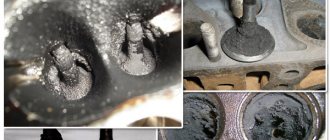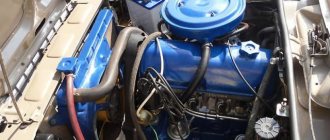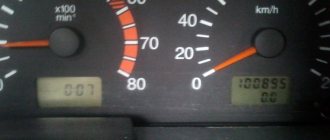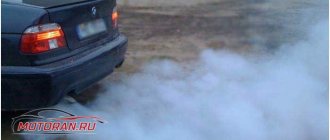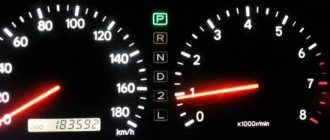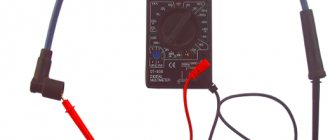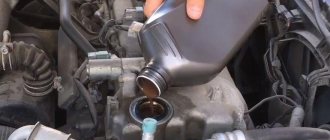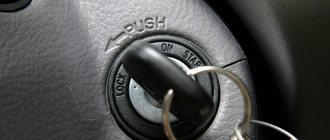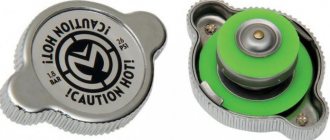Common causes of smoke
As you know, the fuel-air mixture burns in the engine cylinders. The fuel enters here through the injector nozzles and “meets” the air, which is supplied through the intake manifold. The cylinder pistons create the pressure necessary to mix air with fuel. When the entire system works like a clock, the mixture burns almost completely, and the emission of hydrocarbons into the atmosphere is minimal. The smoke that comes out of the exhaust pipe when the engine starts is the result of incomplete combustion of the fuel mixture for various reasons:
- The injection advance angle is off.
- Uneven fuel spray.
- Insufficient air supply to the cylinder block.
- Fuel is of low quality, with a high concentration of sulfur.
Let us immediately note that it is impossible to find out the exact cause of the breakdown only by the type of exhaust. The color of the smoke will tell you where to look for a problem (cooling system, compressor, etc.), which will save time. But an accurate “diagnosis” will only be made by a complete diagnosis of all systems, which is best not to delay.
Coolant leaking
If the cylinders have lost their seal due to wear or there are gaps between the block and the head gasket, coolant may begin to leak into the combustion chamber. It is easy to guess that this happened from the clouds of white smoke from the diesel exhaust pipe. In this case, the engine can stall both cold and warm.
It should be remembered that after repairing the piston system and replacing the cylinder head gasket, tripping can also be observed when cold. But the fact is that the new gasket may be slightly thicker than the old one. If this happens, the compression level in each cylinder is reduced. Therefore, the fuel mixture in the engine ignites intermittently.
Black color of smoke: causes and consequences
The black color of the exhaust is due to its high soot content. Most often, diesel smokes black due to the low cetane number of diesel fuel, or, more simply, due to poor fuel quality. Switching to higher quality diesel fuel will help confirm or refute this guess. If after several starting cycles the smoke color remains the same, then the problem is not in the fuel.
Air filter clogged
The purpose of the filter is to clean the air entering the cylinders from solid particles that can damage the engine. When it becomes clogged, the air supply is reduced, which affects engine power and fuel consumption. If the filter is clogged, fuel burns in vain. If you notice increased fuel consumption along with black smoke, check the filter first. In vehicles equipped with an on-board diagnostic system, the computer will display P0171 or P0172.
The solution to the problem is obvious - the air filter needs to be changed. Car manufacturers advise replacing filter elements every 12 months or every 10-20 thousand km. The “life” of the filter largely depends on the operating conditions of the car. On dusty dirt roads it will clog faster than when driving on smooth, clean asphalt.
The injectors are clogged
If a diesel engine smokes black smoke when cold, does not start on the first try, and stalls when you press the gas pedal, most likely the reason is in the injectors. When using low-quality fuel, tar and sludge accumulate in the spray holes. Cleaning them will help restore the functionality of the injectors. There are two ways to flush injectors:
- Chemical. A special cleaning compound (solvent) is poured into the fuel system and the engine is started several times.
- Physical. The injectors are removed from the engine and placed in a special ultrasonic bath. This method is more effective, although more expensive.
Turbocharger faulty
Black smoke from the exhaust pipe with low engine power and increased oil consumption indicates problems with turbocharging. There may be two reasons:
- air duct blockage;
- Intake/exhaust manifold leaking.
You can even diagnose an air leak by ear - when the engine is turned on, the turbocharging system emits a loud, characteristic whistle. If the turbocharger is silent, you need to turn off the engine and check the air path for blockages.
Fuel injection pump malfunctions
A diesel engine may smoke black due to an incorrectly set injection angle on the high-pressure fuel pump (HPF). The fuel-air mixture ignites with a delay. The pressure in the cylinders increases, which leads to the formation of large amounts of soot. It is better to check and, if necessary, change the injection angle in a car repair shop, since the procedure is complex and requires special equipment. There is no point in delaying this, since long-term operation of a car with an incorrectly set injection angle leads to rapid wear of the parts of the cylinder-piston group.
Another reason for diesel smoke can be wear of the injection pump plunger pairs. This malfunction is indicated by “floating” idle speed when the engine warms up.
Why can't fuel ignite?
Insufficient compression in the cylinder
As natural wear occurs, the gaps between the parts of the cylinder-piston group increase. They are the cause of the pressure drop in the combustion chamber. You can accurately determine the drop in compression using a special pressure gauge. Indirectly, the fact that the compression ratio is insufficient is evidenced by more pronounced tripping when cold and at idle. When hot and on gas, the diesel engine revs less or stops revving altogether.
Since the cylinders wear unevenly, the degree of compression, and therefore the temperature of the compressed mixture, will be different everywhere. As the engine heats up, the temperature of all cylinders increases. Despite the fact that it still remains different in each of them, the fuel ignites reliably and the engine stops stalling.
There are known cases when a diesel engine began to misfire after replacing the cylinder head gasket. The fact is that the cylinder-piston group was badly worn, and the new gasket was slightly thicker than the old one. After the replacement, the compression ratio decreased and the air-fuel mixture began to ignite intermittently.
Faulty glow plug
Glow plugs in a diesel engine perform two tasks. The first is heating the combustion chamber to facilitate ignition of diesel fuel and maintaining a high temperature until the engine warms up. The second task is to improve fuel atomization. A jet of diesel fuel injected through the injector hits the glow plug and is atomized, thanks to which the fuel mixes better with air and burns better.
Thus, if the spark plug fails, the temperature in the cylinder at startup will be insufficient to ignite the mixture, and the cylinder will not work. A similar picture is observed when the voltage of the second glow stage, intended to maintain the temperature in the cylinder, is not supplied to the spark plug. If the heated rod of the spark plug burns out, the jet of diesel fuel that the injector injects will not be sprayed. As a result, mixture formation deteriorates and the engine stalls.
If a diesel engine stalls when cold and at startup, but does not stall after warming up even on gas, the reasons for this may lie in the fact that it is time to replace the glow plugs. You may also experience smoky exhaust due to incompletely burned fuel.
White color of smoke: causes and consequences
In winter, white exhaust from the pipe when the engine warms up is quite normal. This comes out as water, which is a natural product of fuel combustion. Due to the temperature difference, it condenses and turns into steam, which quickly dissipates.
But if a diesel engine smokes white even when the engine is well warmed up and at above-zero temperatures, this indicates problems with the cooling system. Most likely coolant has entered the cylinder block. Most of it consists of water, which forms thick steam when the fuel-air mixture burns. Liquid penetrates into the block due to depressurization of the cylinders themselves or wear of the gaskets responsible for the tightness of the cylinder head or intake manifold.
To diagnose faults, remove the cylinder head and evaluate the condition of all parts of the system. The entry of water into the fuel-air mixture increases wear of all parts. Repairing the cooling system will cost much less than overhauling the engine. Therefore, it is better not to ignore white smoke when the diesel engine is running hot.
Why is there not enough fuel in the cylinder?
Other problems with diesel engine stalling are associated with an insufficient level of the fuel mixture entering the engine cylinders. In this case, tripping also appears on a hot engine and is accompanied by abundant white smoke from the exhaust pipe. Its appearance is associated with the ingress of coolant into the combustion chambers.
The causes of tripping with such symptoms may be the following malfunctions:
- failure or clogging of injectors;
- malfunction of the high pressure fuel pump (HPF).
Diesel engine injectors supply fuel to the cylinder in a strictly prescribed dose according to a specific pattern. Clogging of the injectors is possible due to poor quality diesel fuel or untimely replacement of the fine filter. As a result, fuel is supplied unevenly to the engine cylinders and the engine begins to stall.
Also, tripping can be caused by a malfunction of the high pressure fuel pump (HPF). It is this unit that is responsible for supplying uniform doses of fuel at strictly defined moments. Wear of the fuel injection pump leads to insufficient pressure in the fuel system and a decrease in the intensity of fuel injection into the cylinders. The injection pump simply cannot push a sufficient dose of fuel through the injectors. As a result, the engine triples again.
We recommend: Replacing the crankshaft oil seal Lada 2107 (VAZ 2107)
Most often, the plunger pair in the fuel injection pump fails. Over time, its wear leads to the fact that the diesel engine stops starting altogether, since fuel stops flowing into the cylinders. At the same time, sometimes starting the engine from a pusher or hot is possible, but when starting from a standstill, the engine does not respond to turning the key. Also, fuel injection pump problems may be related to the fuel line, then the engine will trip constantly due to fuel leaks.
The third reason for the tripping associated with the fuel injection pump is associated with incorrectly configured fuel injection. On many car models, the fuel injection pump is equipped with a device that allows the engine speed to increase during a cold start, due to which the injection advances - fuel enters the still unheated engine. As the engine warms up, the speed decreases to standard values. Under load, on the contrary, there is a delay in injection for complete combustion of the fuel mixture.
As the injection pump wears out, this operating pattern is disrupted. The fuel injection advance angle no longer corresponds to the crankshaft speed. As a result, fuel stops getting into the cylinders in a timely manner and the diesel engine begins to stall. In this case, the effect can occur as the engine speed increases and the engine heats up, that is, when “cold” the engine works properly, but “when hot” it starts to malfunction.
Blue color of smoke: causes and consequences
Oil getting into the cylinders
In this case, the exhaust takes on different shades of blue: from pale blue to swirling whitish blue. The color of the smoke depends on the operating mode and degree of engine warm-up, as well as the concentration of oil that has entered the cylinders.
A simple test will help you check for oil in the exhaust. With the motor running, cover the pipe with a sheet of paper for a few seconds. If greasy drops appear on it, it means that oil has leaked into the combustion chambers. This is possible if the compression rings are worn out or the cylinder surface is damaged due to abrasive particles. If the car has been parked for a long time, pockets of corrosion may appear on the cylinders and compression rings.
The degree of wear of parts can be determined by the color of the smoke. If the blue color of the exhaust only appears when it warms up, wear is still insignificant. If parts are severely damaged, the smoke only increases.
Sometimes a diesel engine smokes blue smoke due to the fact that the oil scraper rings have lost their springiness. Motorists call this phenomenon stagnation. The rings do not fulfill their intended purpose and oil enters the engine cylinders.
Compression drop
You can diagnose a drop in compression in the cylinders of a diesel engine by the thick black exhaust at startup. A large pressure difference leads to unstable operation of the motor. In cold weather, a unit with weak compression may not start at all - there will not be enough temperature to ignite the fuel mixture.
Another cause of blue smoke is burnout of cylinder valves, accompanied by increased oil consumption. The problem can be easily diagnosed by checking the compression in all cylinders - in the damaged one it will be very low. Burnout of the valves is also indicated by an increase in carbon deposits on the spark plugs.
Sometimes the engine smokes blue due to a ruptured regulator membrane in the automatic transmission. The membrane cavity extends into the intake manifold, and when starting, the engine sucks oil from the automatic transmission.
Unburned fuel
This assumption will be confirmed by the presence of a strong pungent odor from the exhaust system. This means that unburned fuel comes out with smoke in the form of vapor.
Fuel may not burn for various reasons. It may be that the fuel is delivered too late or one of the cylinders is not doing its job and is unable to burn the fuel.
As a rule, every consequence has its own cause. The consequence of this is unburned fuel and, as a result, blue smoke from the engine. So what reasons and problems in diesel units can cause this?
Injection pump faulty
If the cause of the blue smoke is untimely injection, pay attention to the wear of the injection pump (fuel injection pump). It is easy to guess that the fuel will not burn if it is delivered late.
So, we have identified one of the possible culprits. But why is this so? The design and layout of the injection pump is not simple. To explain in simple words, the operation of this unit is based on the movement of special fuel supply mechanisms, which constantly rub and touch each other.
The lubricant for the parts is the fuel itself. Quite a difficult decision, since diesel fuel has an oily structure. However, with the onset of winter there is a transition to winter fuel.
It is called winter because the viscosity decreases, namely due to the absence of these lubricating fractions or their quantity is insufficient to lubricate the “equipment” in the pump. This is the cause of pump wear. Wear of this part of the unit, in turn, along with the wave profile of the sprinkler, causes a delay in fuel injection.
The mechanism is this: the fuel does not have time to warm up due to the injection delay and the cylinder begins to work poorly intermittently. As a result, fuel that does not burn comes out as blue smoke.
If the engine warms up after driving a few kilometers, the bluish trail behind the car will disappear or become so small that it can no longer be traced. However, the pump failure will not be corrected. When the engine is warmed up, even fuel supplied late has time to burn almost completely due to the high background temperature.
Poor engine compression
There are times when strong blue smoke appears when starting the engine. And then, when heated correctly, the smoke disappears. This picture is quite common in the yards of our country, when columns of smoke appear and the driver runs, clutching his head, and cannot understand what is happening.
The reason is low engine compression. Due to this defect, the compression temperature does not reach the correct value, so the fuel does not burn completely. Even if the engine has one cylinder with low compression, operation of such an engine is possible. But he will continue to smoke until
Blue smoke can be caused by mistimed injection or low compression.
The cause of blue smoke may be untimely injection or low compression. By the way, most modern diesel engines are equipped with a device on the fuel pump that performs early injection while the engine is still cold.
Other causes of smoke in diesel engines
- Malfunction of the CCVV (crankcase ventilation valve). This problem is typical for BMW cars. When accelerating hard, the diesel produces thick white smoke. Replacing the valve solves the problem.
- Engine oil overheating. The problem manifests itself under extreme loads on the engine (full weight load, prolonged ascent) - then thick white smoke pours out of the muffler. The solution is to replace the oil with a higher quality one and not subject the engine to overload.
- Worn or hardened valve seals. The problem is typical for domestic cars with a diesel engine. It manifests itself as an abundant emission of white-blue smoke in the first seconds after starting the engine. As it warms up, the smoke goes away. The solution is to replace the valve stem seals.
Lost compression in diesel engine
The crank mechanism in the engine must ensure synchronous movement of the pistons in the cylinders. Over time, during operation, parts of the cylinder-piston group (CPG) are subject to various wear, gaps and backlashes appear. This all reduces compression. Gas distribution valves wear out more often than pistons and cylinders, and gaps appear that do not provide the required compression.
Diesel fuel cannot heat up and spontaneously ignite if the degree of compression is insufficient. This is the reason why diesel engines have trouble starting. For high compression, the cylinders must be free of scoring and cavities. Pistons with rings should also be free of chips and the rings should not be stuck or bent. The valves must fit tightly into their seats; if there are cracks or chips, then, accordingly, the compression will not be maximum.
We recommend: Replacing the front engine mount of a VAZ 2114
If the compression is not enough to heat and ignite the diesel fuel, then the diesel engine starts to burn when it is cold. When hot, a diesel engine runs much less, since the mating parts of the cylinder-piston group are expanded, which leads to the creation of increased compression (compression). This phenomenon, when a hot diesel engine calms down and shakes less, means that there are no serious breakdowns of the crank mechanism and timing valves.
Many drivers already buy themselves a pressure gauge to measure the compression pressure in the cylinders. It costs approximately 2000 rubles at the beginning of 2021. Using this measuring device, you can easily understand what pressure is created (atmospheres or MPa (megapascal)). How much compression should be should be found out for each make and model of car individually.
The slight wear of the parts of the cylinder-piston group is compensated by the fact that when the engine is hot, the diesel fuel ignites much more easily; even with low compression, self-ignition occurs.
This phenomenon also occurs when a new cylinder head gasket (cylinder head) has just been installed. Usually, in this case, the behavior of the motor is that in a cold state the engine shakes a lot, and in a hot state it does not shake at all or adjusts. This is due to the fact that the new cylinder head gasket is thicker, so less compression is created.
Anti-smoke additives - a panacea or a waste?
Various auto chemical brands offer special additives to reduce oil consumption. They form a film on the rubbing parts of the engine that protects them from wear and fills existing microcracks. The use of additives replaces the decoking of piston rings, cleaning them from dirt. Manufacturers promise all this, but is it really so?
On auto forums you can find conflicting opinions about anti-smoke additives. Some auto mechanics note that the use of such products makes it difficult to overhaul the engine. The engine parts are covered with an oil layer, which is very difficult to completely wash off. Individual parts that could simply be cleaned have to be replaced, which means repairs are more expensive.
The additive only slightly extends the life of the engine before repair, but does not guarantee its trouble-free operation.
The engine runs rough both on gas and at idle speeds
Interruptions in engine operation in all modes indicate either problems in the power system or irregular valve timing. But, however, there may be more serious problems - such as burnout of the piston crown or breakdown of timing parts (for example, breakage of valve springs or burnout of a valve).
Interruptions in engine operation in all modes indicate either problems in the power system or irregular valve timing. Typical malfunctions of the power system include clogging of injectors, fuel filters, air leaks and are determined during complex diagnostics https://diesel-remont78.ru.
Even cleaning the injectors of a modern diesel engine requires quite expensive equipment, let alone repairing the injection pump... Therefore, if the diesel engine is running “hot” at idle, it is best to contact a qualified specialist. Self-repair can lead to unjustified expenses - if you randomly replace parts, then diagnostics and repairs will cost a pretty penny. Sometimes, even for a specialist, it’s a mystery “why does a diesel engine stall?” becomes a tough nut to crack - modern fuel equipment cannot be diagnosed by eye, and the abundance of electronics does not make the task easier. If old diesel engines could operate practically under water (provided that it did not enter the intake tract), then a modern engine can simply stall in wet weather.
We recommend: Installing a towbar on a Renault Duster with your own hands: installation instructions with photos
